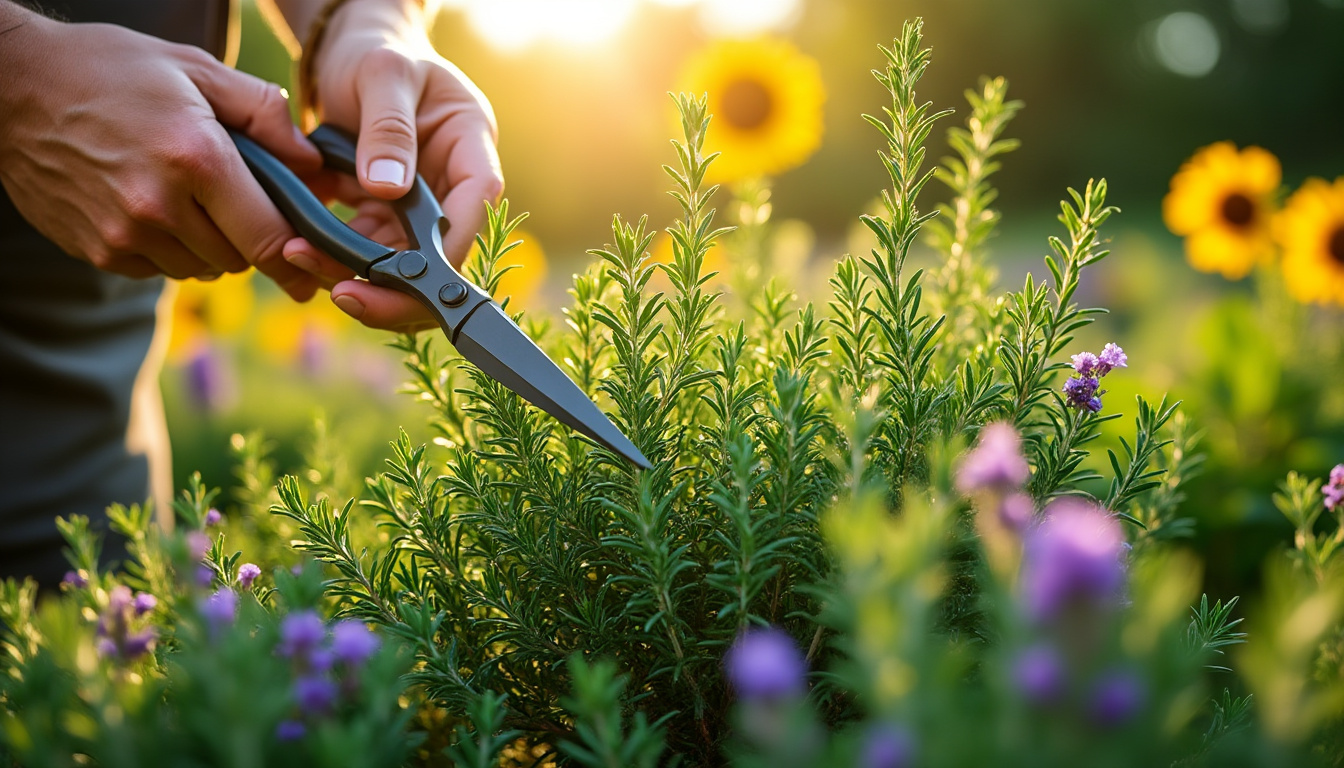Understanding the optimal timing for pruning rosemary is crucial for achieving the best results in growth and health. Different stages of the growth cycle of rosemary plants dictate when and how to prune them effectively. This article will delve into the various aspects of rosemary pruning, including the best timing, techniques, and common mistakes to avoid, ensuring that your plants remain healthy and vibrant.
- Timing for Optimal Pruning
- Understanding Rosemary Growth Cycles
- Techniques for Proper Pruning
- Common Mistakes to Avoid
- Post-Pruning Care for Rosemary Plants
Timing for Optimal Pruning
Timing is everything when it comes to pruning rosemary effectively. While it can be pruned at different times throughout the growing season, certain periods yield the most favorable results for the plant’s growth.
The Best Times to Prune Rosemary
The optimal time for pruning rosemary falls primarily in the late spring and early summer after the flowering period. This timing allows the plant to recover and flourish during the active growth phase.
- Prune in Early Spring: As the risk of frost wanes, rosemary plants should be pruned to provide room for vigorous growth.
- Post-Flowering Trim: After blooming, pruning can help direct the plant’s energy towards producing foliage rather than flowers.
- Late Winter Precautions: Avoid pruning in the late winter as new growth may be compromised by frost damage.
| Timing | Activity | Purpose |
|---|---|---|
| Early Spring | Initial pruning | Encourage growth before flowering |
| Late Spring | Prune after flowering | Focus on leaf production |
| Summer | Light maintenance | Shape the plant |
Considerations for Pruning Older Rosemary Plants
Older rosemary plants may require a slightly different approach. While the usual timetable applies, recognizing the specific needs of mature bushes is vital. With aging, rosemary may develop woody stems that can become unproductive. Pruning older plants in spring allows them to regenerate new growth effectively.
Moreover, it is essential to ensure the health of the plant before deciding to prune heavily. Removing no more than one-third of the plant in one session will minimize stress and encourage robust recovery.
Understanding Rosemary Growth Cycles
To prune rosemary effectively, it’s important to have a comprehensive understanding of the growth cycles of this plant. Rosemary exhibits periodic growth phases throughout the year that contribute to its overall health and floral production.
Different Stages of Rosemary Growth
Understanding the growth cycles is key to determining when to prune. Rosemary experiences the following stages:
- Dormant Stage: During cold months, rosemary plants enter dormancy and should be left unpruned.
- Active Growth Stage: In spring, new growth emerges, making it an ideal time for pruning to shape the plant.
- Flowering Stage: Early summer sees flowering, after which a trim promotes healthy foliage.
| Growth Stage | Characteristics | Pruning Recommendations |
|---|---|---|
| Dormant | Minimal activity | Avoid pruning |
| Active Growth | New shoots and leaves | Prune gently to shape |
| Flowering | Blooms appear | Trim after flowering |
Observing Plant Health
Monitoring the health of the rosemary plant is essential. Signs of distress such as wilted leaves or stunted growth may indicate a need for immediate pruning. In contrast, plants that are healthy and thriving might only require routine maintenance pruning.
Techniques for Proper Pruning
Pruning rosemary requires specific techniques to ensure healthy regrowth and maintain the plant’s shape. Understanding these techniques is crucial for successful pruning that promotes growth and aesthetics.
Essential Tools for Pruning Rosemary
Before beginning the pruning process, it is good practice to gather the right tools:
- 🔪 Bypass Pruning Shears: Essential for making clean cuts that encourage new growth.
- 🧤 Gardening Gloves: Protect hands from scratches during pruning.
- ✂️ Sanitizing Solution: Clean tools to prevent spreading diseases.
| Tool | Purpose | Recommendation |
|---|---|---|
| Bypass Shears | Make clean cuts | Use for all pruning |
| Gloves | Protect hands | Ensure safety |
| Sanitizing Solution | Prevent disease | Wipe tools before use |
Step-by-Step Pruning Process
The following steps outline a systematic approach to pruning rosemary plants effectively:
- 🪴 Inspect the plant to identify dead or damaged branches.
- ✂️ Remove these branches first to promote healthier growth.
- 🌱 Shape the plant by trimming back any long or leggy growth.
- 🚿 Sanitize the cutting tools frequently to avoid disease spread.
- 📏 Limit removal to no more than one-third of the plant.
Common Mistakes to Avoid
Even experienced gardeners can fall victim to common pruning mistakes that can hinder the growth of rosemary plants. Awareness of these mistakes and knowing how to avoid them is crucial for maintaining plant health.
Top Pruning Mistakes
- 🚫 Over-Pruning: Cutting back more than one-third can weaken the plant’s structure.
- 📅 Incorrect Timing: Pruning in early spring before the last frost may damage new growth.
- 🧼 Tool Sanitization Neglect: Failing to clean tools can spread diseases.
- 🏁 Ignoring Plant Health: Pruning unhealthy plants severely can lead to further decline.
| Mistake | Effect | Recommendation |
|---|---|---|
| Over-Pruning | Weakens plant structure | Limit cuts to one-third |
| Incorrect Timing | Stunts growth | Wait for past frost |
| Tool Neglect | Spread diseases | Sanitize tools regularly |
Enhancing Awareness
Being proactive about pruning mistakes can help in strategy planning for healthy rosemary growth. Observing how the plant responds after each pruning session is essential for refining techniques for the future.
Post-Pruning Care for Rosemary Plants
After pruning, the care administered to rosemary plants is vital for their recovery and growth. Providing an adequate environment will facilitate their health and vigor.
Essential Post-Pruning Care Tips
Once pruning is completed, consider taking the following care steps:
- 💧 Water Adequately: Ensure plants receive sufficient water without becoming over-saturated.
- 🌾 Fertilize Sparingly: A light layer of compost can aid recovery; avoid over-fertilization.
- 🌞 Ensure Sunlight: Keep the plants in a well-lit area to promote growth.
| Care Level | Action | Frequency |
|---|---|---|
| Watering | Check moisture | Every few days |
| Fertilizing | Add compost | Once after pruning |
| Sunlight | Check location | Daily |
Observing Growth After Pruning
Keeping a close watch on how your rosemary responds to pruning informs further decisions regarding maintenance. New growth is a positive sign of recovery, and timely adjustments can enhance ongoing health.
This very resilient shrub blooms 10 months a year and its butterfly-shaped flowers are majestic
Frequently Asked Questions
How often should I prune rosemary?
Rosemary should be pruned at least once a year, ideally in early spring or after flowering, to maintain a healthy shape and encourage new growth.
What tools do I need to prune rosemary effectively?
Sharp bypass pruning shears, gardening gloves, and a sanitizing solution are essential tools for effective pruning.
Can I prune rosemary in the fall?
It is advisable not to prune rosemary in the fall, as this can lead to tender new growth that may not survive the winter.
How do I know if my rosemary needs pruning?
Signs that rosemary needs pruning include overgrowth, woody stems, or if the plant appears leggy or unhealthy.
What should I do if my rosemary is becoming too woody?
Woody rosemary may benefit from a rejuvenation pruning in spring, but be careful not to remove too much at once. Consider taking cuttings from the plant to propagate new growth.















